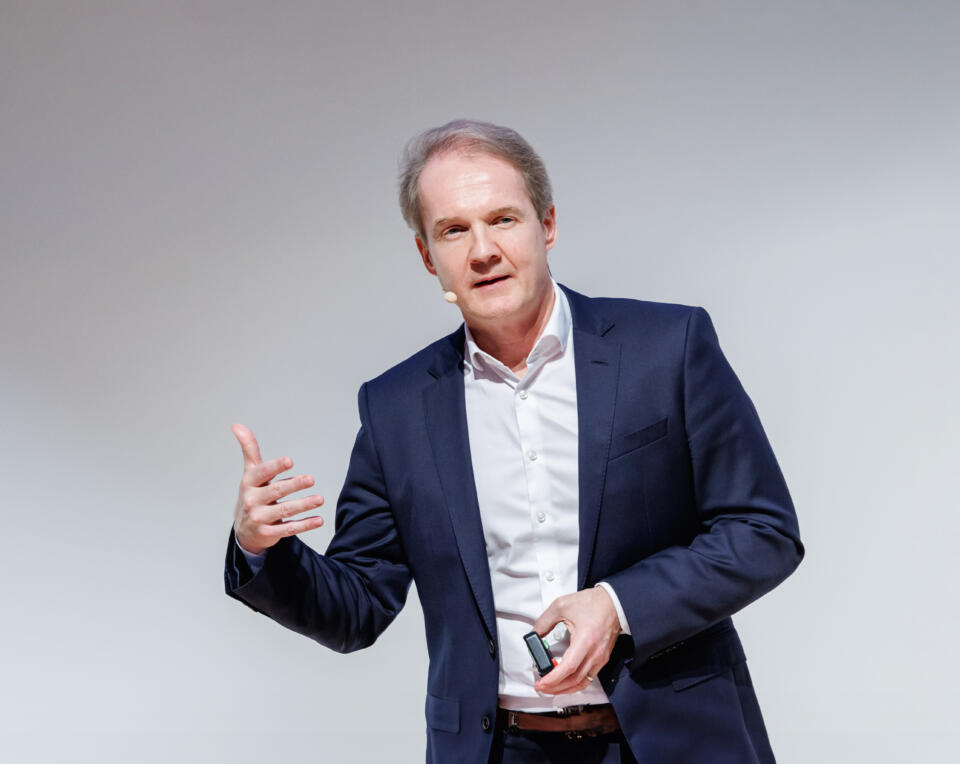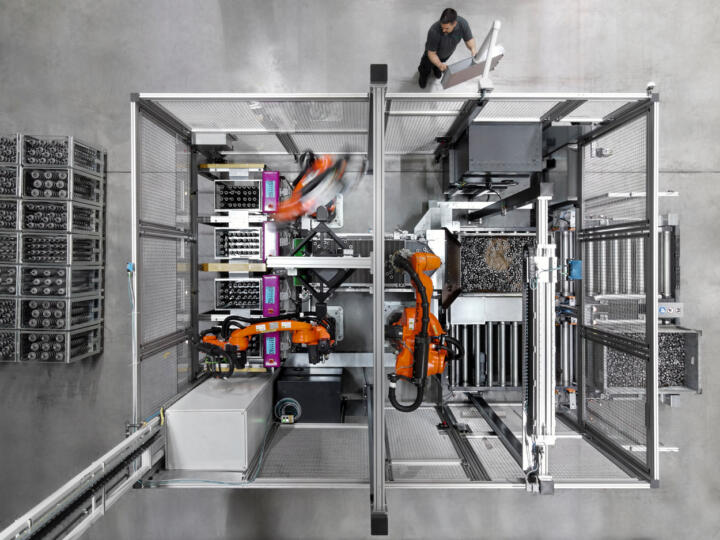
“Efficiency and innovation make us even more sustainable”
Mr. Schick, the Operations department encompasses major parts of the value chain. Of all the challenges Schaeffler faces today, sustainability in particular is a key issue. Where does Schaeffler stand here?
Our goal is to achieve sustainability along the entire value chain. This is a top priority for Schaeffler. As a motion technology company, we have set ourselves the overarching goal in our Roadmap 2025 of becoming completely climate-neutral by 2040. This is very ambitious, perhaps even more ambitious than the market average. But that is exactly what sets us apart: We consistently place sustainability at the center of our strategy. This aligns perfectly for us as a family-owned business with a long-term objective embedded in our DNA and exemplified by our family shareholders. Renewable energies and energy efficiency in production play a key role in our operations. We are also consistently reducing the consumption of natural gas in our plants.
Can you give us a more in-depth insight into the status of these measures?
One of our goals is to achieve carbon neutrality in production by 2030. To accomplish this, we are gradually reducing the use of natural gas and crude oil. We are currently about halfway there. In Scope 2 – the purchase of climate-neutral electricity – we are already more than 75 percent of the way there. By 2025, all relevant production sites in all regions will be purchasing climate-neutral energy. We have launched our first pilot projects for the use of hydrogen. In these, we are analyzing the use of hydrogen-powered furnaces.
Where does Schaeffler need to step up its sustainability activities?
We still need to improve in Scope 3 upstream, i.e., materials purchasing. We need to be even more consistent and focused in our measures and activities to achieve our goals. This need is attributed to our successful sales growth in recent years. As a result of it, we have had to purchase significantly more steel as a production material, which has had a negative impact on our overall carbon footprint.
Nevertheless, the purchase of steel is necessary. What is the role of steel at Schaeffler?
Steel is the material that dominates Schaeffler’s product portfolio. This is true for more traditional products such as clutches or bearings as well as for new e-mobility products, some of which require higher quality steel. Today, 65 percent of our material list consists of steel and steel-related products. We expect this percentage to decrease only slightly by 2030. This is because both today and in the foreseeable future, cars and production facilities will continue to be largely made of steel. In terms of our industrial processing, this means in absolute figures that Schaeffler processed more than one million tons of steel in 2023 alone. Decarbonizing this material is the big challenge. How can this large amount of steel be produced without carbon? One approach is to use carbon-free energy at Schaeffler. To meet our own energy needs from renewable sources, we need solar farms with a total area of about ten square kilometers.
One option is the purchase of green steel. What does use Schaeffler to classify steel as green?
Schaeffler’s sustainability classification comprises four groups of steel: gray, light green, medium green, and green. For Schaeffler, steel is green if it has a footprint of less than 400 kilograms of CO₂ emissions per ton. Unfortunately, we do not currently have any steel that we can internally classify as completely green. This is mainly due to the fact that it is not yet available on the market. The path to decarbonizing steel is still too slow. In 2023, 90 percent of Schaeffler's greenhouse gas emissions were generated before our own processing. At present, steel production still causes very high CO₂ emissions of 2.2 to 2.5 tons of CO₂ per ton of steel. Promising sustainable alternatives for the future include steel produced in electric arc furnaces and the use of green hydrogen as an energy source in their production.
How does Schaeffler intend to ensure the procurement of green steel?
For some time now, we have been informing our steel suppliers that in the future we want to buy more sustainable or green steel according to our classification. We also need reliable and strong partners who are willing to move forward with us in order to achieve environmentally friendly procurement. Our promising partnership with the Swedish start-up H2 Green Steel, for example, is providing us with momentum in this regard.

What makes this partnership so special?
H2 Green Steel is the first steel manufacturer to produce industrial green steel according to our classification. In fact, the first new steel plant in Europe in more than 30 years is being built for this purpose. Starting in 2026, Schaeffler will gradually purchase 100,000 tons of the nearly carbon-free steel produced there. The start-up relies on the aforementioned steel production using green hydrogen. The latter is of vital importance here. The desired climate neutrality can only be achieved if the hydrogen itself is produced in a CO₂-neutral manner using renewable energies. And the effect is enormous. Through this approach, we will avoid up to 200,000 tons of CO₂ emissions annually from 2026 onwards. Our strategy is to intensify our cooperation with such innovative partners in the future.
Let’s talk briefly about digitalization. How do you see the role of artificial intelligence – as more of a threat or an opportunity?
Both: It is a great opportunity if we can quickly understand the application of generative AI, but it is also a risk if we do not recognize the new possibilities or are slower than our competitors in integrating them into our processes. At Schaeffler, we must learn to integrate the digital solutions that are now emerging into our core processes. “Copilot for everything” is a favorite phrase of mine. By this I mean supporting AI solutions that generate new content based on existing information and user specifications. The potential for automation here is enormous. Copilots can be implemented in all of our value-added processes.

Can you give us an example?
We are a pilot user of the first Industrial Copilot, which we are developing in cooperation with Siemens. It automates PLC machine programming using generative AI. The machine now understands the human language – you could say that the system now listens to our engineers. This type of communication makes it possible to carry out complex work processes in just a few minutes, delegating repetitive tasks to the copilot. In February, Schaeffler showcased the impressive functionality of the Industrial Copilot at the Siemens Annual General Meeting. The demonstration was conducted in real time, together with the CEO of Siemens AG, Dr. Roland Busch.
In the past, you have often spoken of the “decade of efficiency”. What do you mean by that?
By this I mean the increase in efficiency that we will see in more and more areas, including through the future use of copilots. The time required to program machines will be reduced and this will extend to other tasks on our shop floors. For example, when preparing tools or taking measurements, a team leader could send the relevant information to a copilot during running production, saying: “Here’s how to do this setup or this measurement.” The best solutions would then be provided based on the data collected. That kind of efficiency potential exists in all areas. The technological solution is there; the next step is to use it.
How do you see Operations positioned at Schaeffler for the future?
With “Next Level Operations”, we have defined six fields of action that we use to align our work with the future. These areas are innovation, agility, efficiency, sustainability, resilience and, last but not least, people. At the Global Production Forum 2023, we discussed challenges as well as solutions in these areas. For example, increasing efficiency is closely connected to the use of the latest technology solutions. At the same time, skilled teams capable of implementing these solutions are the backbone of our future success. Sustainability is probably the greatest challenge of our time, not only for us, but also from a global perspective. At the same time, we need resilient supply chains in order to achieve our goals. As you can see: The issues are inextricably linked.
Thank you for the interview, Mr. Schick.


